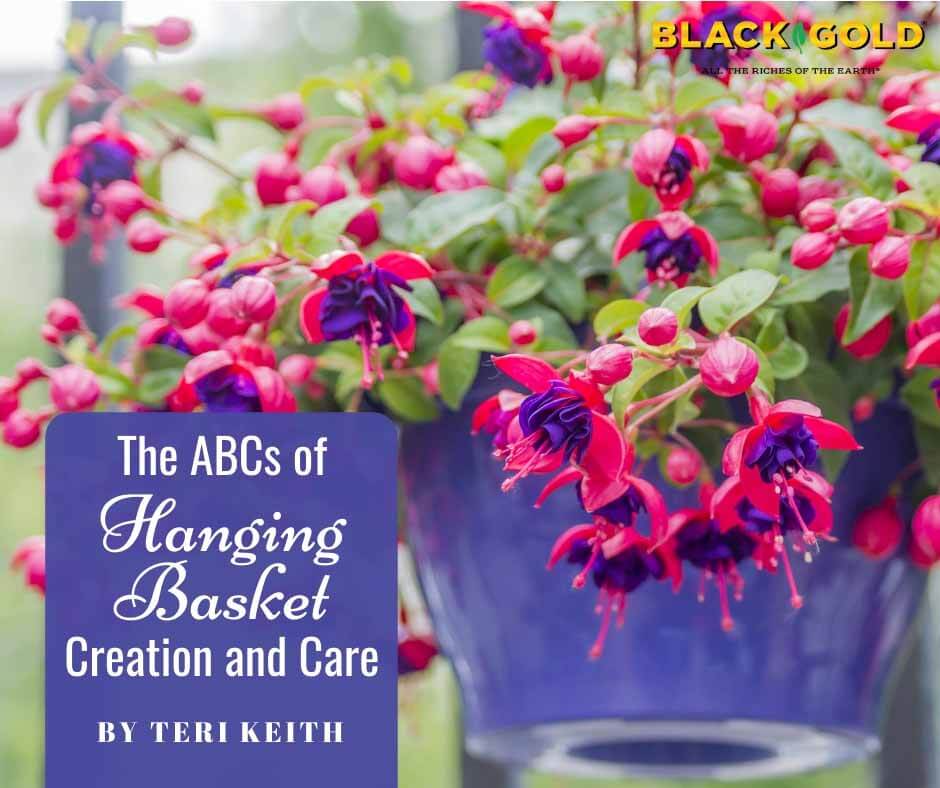
Spring is finally here, and many of us have been bitten by the Flower Bug. We are looking forward to beautiful pots on the deck and hanging baskets on the front porch full of gorgeous flowers. It is fun to make up your own hanging baskets, using last year’s baskets or new ones. The key to success is choosing the right pots, soil, and plants, and then giving them the right care. If you get everything right, you’ll have beautiful baskets all season long.
A. Choosing a Basket

There are many types of hanging baskets made of different materials. Self-watering plastic baskets or those made of ceramic hold water the best, while coir-lined wire baskets or those made of resin rattan and wood drain freely but often lose water more readily. Solid baskets hold onto water better but lack the appealing look of the coir baskets and do not drain as well. Baskets are available at garden centers, nurseries, and big box stores. Buy large ones if you want more than one plant per basket. They will have room for both trailing and mounded plants and also require less water.
Reusing old baskets is also practical and economical. Just be sure to dump out the old soil, wash them thoroughly with soap and warm water, and let them dry in the sun before use.
B. Choosing Hanging Basket Plants
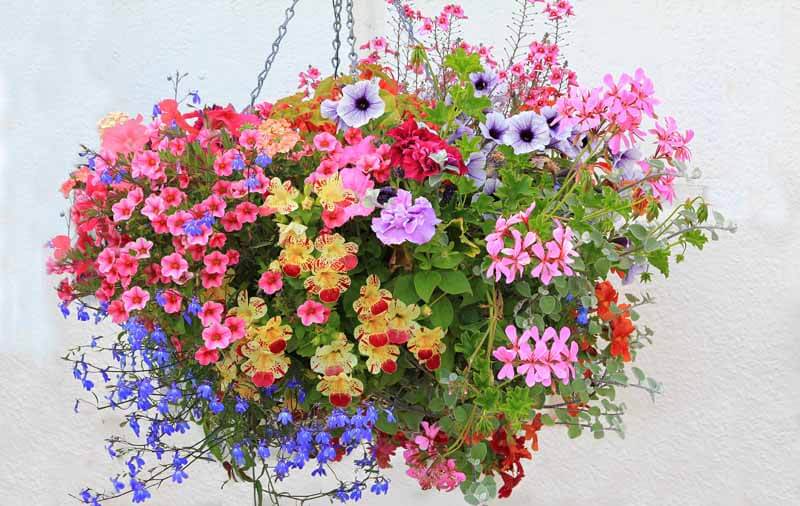
I like to plant up my own baskets because it is less costly and allows me to be creative. Others may prefer to buy fully grown, complete baskets. These are always lush and beautiful, but be wary before you buy. Those planted up with too many plants tend not to last because they are too crowded. They will look good in the short-term but will quickly lose their luster.
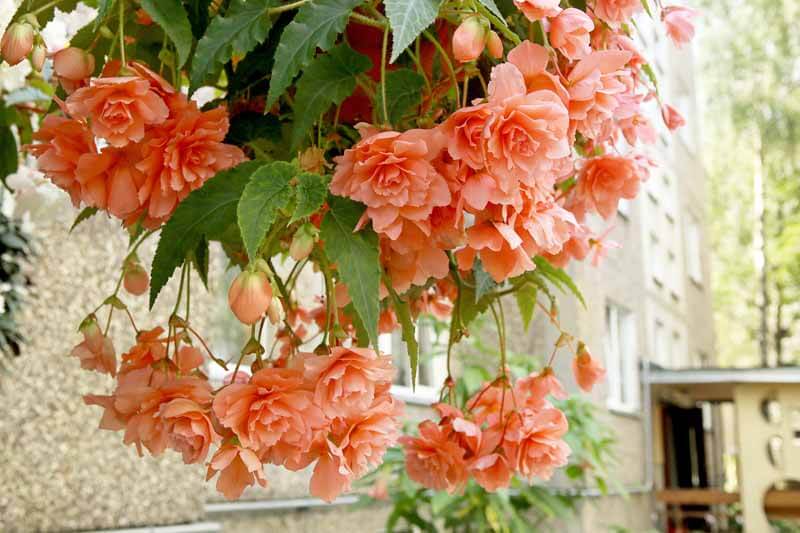
If you take the more economical approach, here are some favorite hanging basket plants that have grown well for me. As a bonus, almost all the flowers listed here are loved by bees, hummingbirds, and butterflies.
Cascading begonias (Begonia x tuberhybrida Pendula Group) like shade, especially in hot weather. Further north where summers are milder, they can be grown in partial sun, but in the Midwest and more Southern regions, shade or filtered light will keep them looking their best. Cascading begonias have large, glowing, flowers, in shades of yellow, pink, orange, and red, and will trail up to 20 inches over the sides of the basket. A truly spectacular selection is Illumination® Rose Tuberous Begonia, which cascades beautifully with double, rose-red flowers. ‘Apricot’ is another exceptional form with double apricot blooms that truly hang downwards.
Fuchsia (Fuchsia hybrids) are among the most beautiful cascading plants with pendulous flowers that attract hummingbirds. They will grow well in full sun or partial shade, but shadier locations are preferred in areas with hot, dry summers. Fuchsias have tubular inner flowers with showy outer sepals that often curve back. Usually, the flowers are bi-colored, with blooms in differing colors or shades of
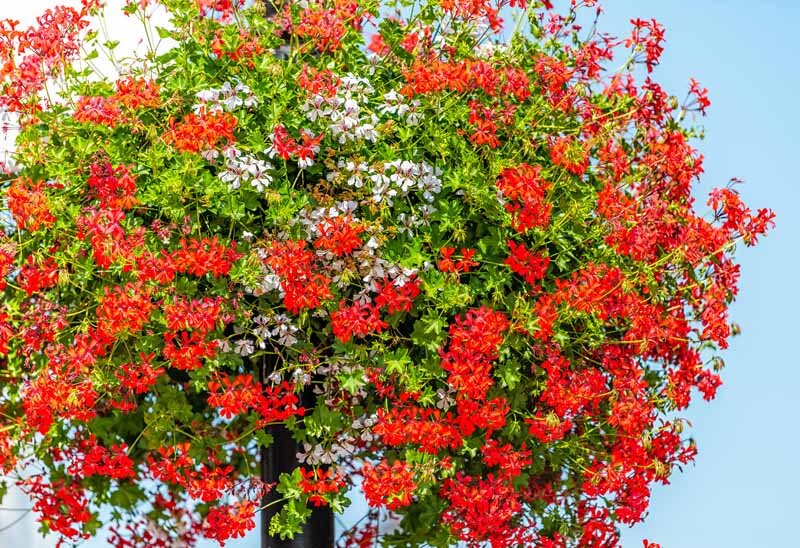
crimson, pink, purple, and white. Especially stunning are those with double flowers and ruffled edges. Dark Eyes trailing fuchsia is one with red sepals and a purplish inner ruffle. When buying fuchsia at garden centers, choose larger, well-established specimens for a faster summer show, and don’t allow them to get dry in the pots for any length of time.
Ivy geraniums (Pelargonium peltatum) are cascading annuals that enjoy full sun and can take the heat. They cascade up to 20 inches and are called ivy geraniums for their ivy-shaped leaves. They branch well, keeping the stems thick with flowers. Most of the flowers are single, but a few are semi-double. They come in shades of pink, red, salmon, and white, and they like full sun. Try the classic ‘Balcon Royale Red’, a reliable form that produces loads of bright red flowers and can cascade down to 3-feet.
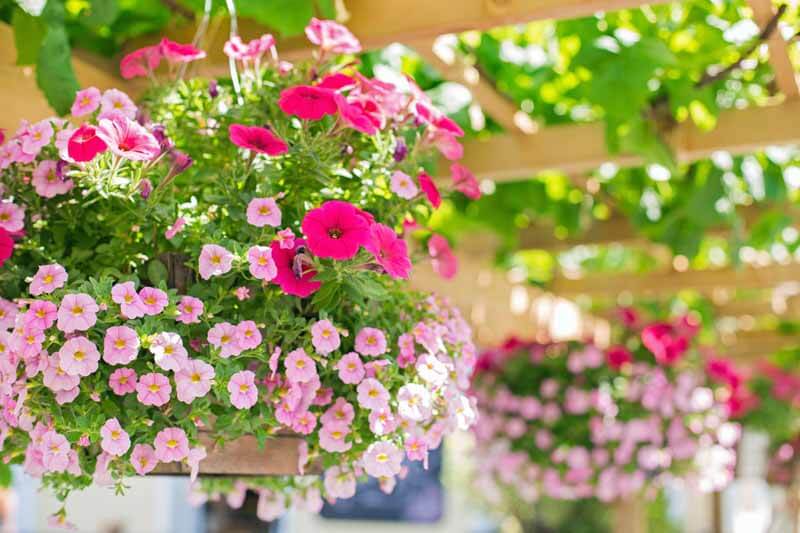
Petunias (Petunia hybrids) are old sun-loving favorites that have been bred into the most fabulous new varieties. In particular, look for Proven Winners Supertunias. Both the regular-sized Supertunias and Mini Vistas will mound in the center and spill over the sides of a basket. Last year I grew Supertunia® Mini Vista™ Violet Star, a striped purple-and-white flowered form with small, less than 1-inch-wide flowers. It never needed deadheading or pruning and just stayed perfect until the end of the season. These petunias come in many colors and blends.
Trailing verbenas (Verbena hybrids) tolerate heat and sun very well and will continue to bloom and perform with regular water. Keep an eye out for the Lanai Series of lantanas. They form a 10-inch tall mound that stays looking beautiful all summer and cascades 18 inches over the side. Lanai® Blue Verbena, with its pure violet-blue flowers, is very eyecatching. Proven Winners Superbenas are even more high performing and bloom nonstop all summer. The apple-blossom pink Superbena Sparkling® Rosé is my favorite.
Calibrachoa (Calibrachoa hybrids) look like very small petunias. Of these, I
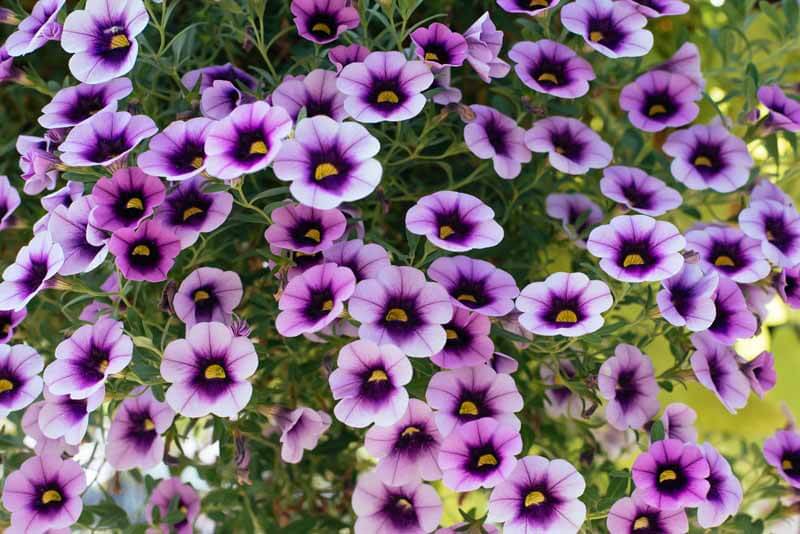
like Superbells® varieties, but Million Bells® are also reliable. They are available in many different colors with doubles and single flowers (click here to view them all). Superbelles create a 6- to 12-inch mound in the center of the basket that cascades to 2 feet over the edges. Superbells® Blue Moon Punch™ is a cool lavender with a purple eye that mixes well with pink or white Superbenas. Calibrachoa need full sun but also do well in half-day sun.
Other plant ideas for hanging baskets include the use of just foliage plants. Think beyond your average Boston fern, as pretty as they are. Ornamental sweet potato vine (Ipomoea batatas hybrids), golden moneywort (Lysimachia nummularia ‘Aurea’), dichondra (Dichondra argentea), variegated ivy (Hedera helix hybrids), and small-leafed thymes, such as wooly (Thymus pseudolanuginosis), creeping pink (Thymus serpyllum), and lemon (Thymus x citriodorus) thymes, are all easy to grow in baskets. Gardeners with very little time can even try growing the effortless succulent string-of-pearls and its relatives (click here to learn more about growing string-of-pearls.).
My list offers just a sample of what’s available, so look beyond it. I recommend checking out some of Proven Winners hanging basket recipes, as well as other online sources. There are so many wonderful hanging basket plants for sun and shade.
C. Planting and Caring for Hanging Baskets
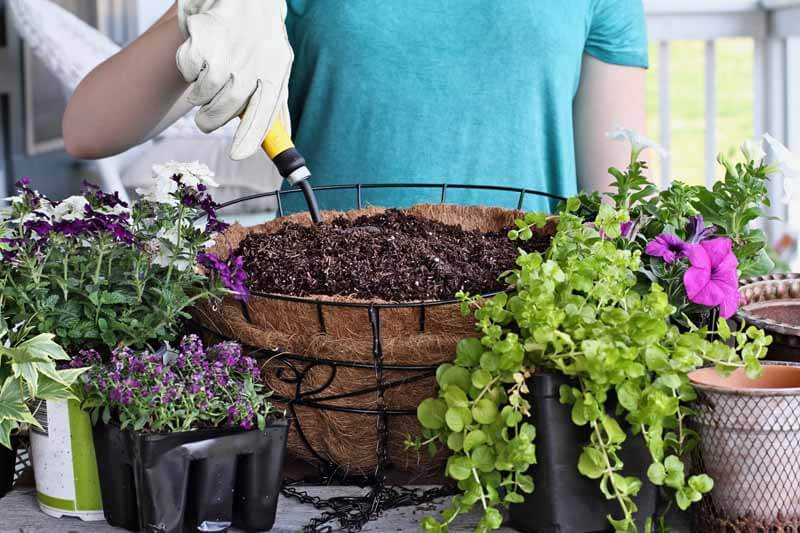
Choose soil that holds lots of water but is also aerated. Black Gold has several excellent options. Black Gold Moisture Supreme Container Mix has a very high water-holding capacity, as does Black Gold Waterhold Cocoblend, which is OMRI Listed for organic gardening. Both contain all-natural Sun-Coir, which retains water for a long time.
When deciding upon plant sizes, keep in mind that those in small cell packs take much longer to grow than fuller plants in 4-inch pots, so choose the latter if you want a faster show. Also, consider the growing needs, appearance, and mature size of each plant to make sure they will look good and grow well together. For example, a trailing fuchsia planted alongside a variegated ivy would be a good combination for shade. In many cases, however, one full plant per basket is sufficient.
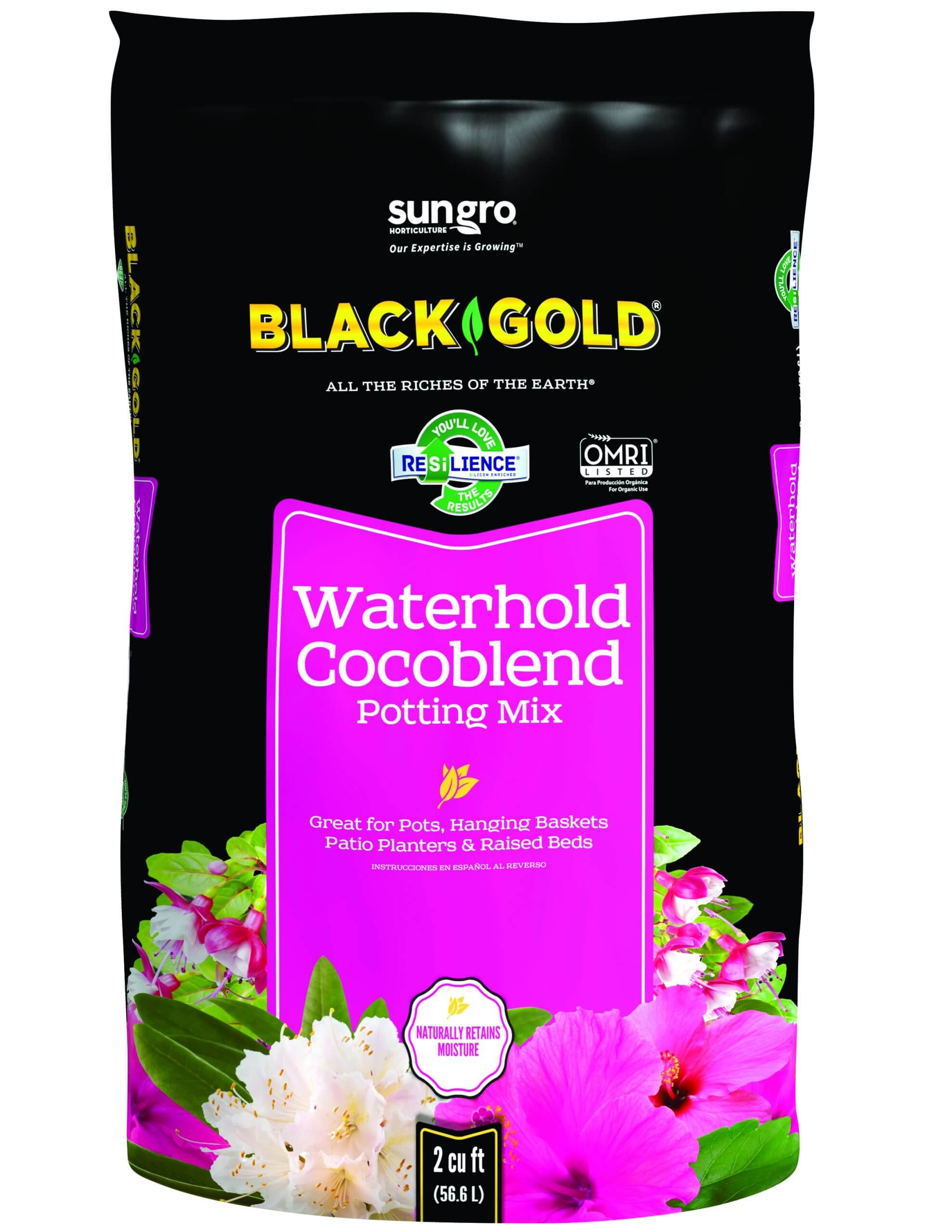 At planting time, fill the bottom of the basket with potting soil. If planting more than one plant per pot, be sure to place them several inches away from one another. Gently pull their roots apart if they are rootbound. Be sure to cover the roots and continue filling until the surface of the soil is just below the basket rim. Then feed with a time-released fertilizer, such as Proven Winners Continuous Release Plant Food, using the manufacturer’s recommendations.
At planting time, fill the bottom of the basket with potting soil. If planting more than one plant per pot, be sure to place them several inches away from one another. Gently pull their roots apart if they are rootbound. Be sure to cover the roots and continue filling until the surface of the soil is just below the basket rim. Then feed with a time-released fertilizer, such as Proven Winners Continuous Release Plant Food, using the manufacturer’s recommendations.
Watering hanging baskets properly is the biggest challenge for many gardeners. Don’t forget that hanging baskets dry out faster than pots, window boxes, or rail planters because they are more exposed and often smaller. As the roots fill up the basket, they have less room to spread and often need watering every day. Underwatering is the most common problem with hanging baskets, but on rare occasions, shade baskets can be overwatered, resulting in root rot. Be sure you invest in a long-necked watering head to make it easier to reach the baskets.
If some of the plants should start looking ratty by midsummer, just do a light pruning when you put in the fresh fertilizer, and they will bounce back.
Nothing looks prettier than a patio or porch lined with festive hanging baskets. I hope this gets you started dreaming about summer, and the beauty that comes with it. Who knows, maybe we can go outdoors by then.

